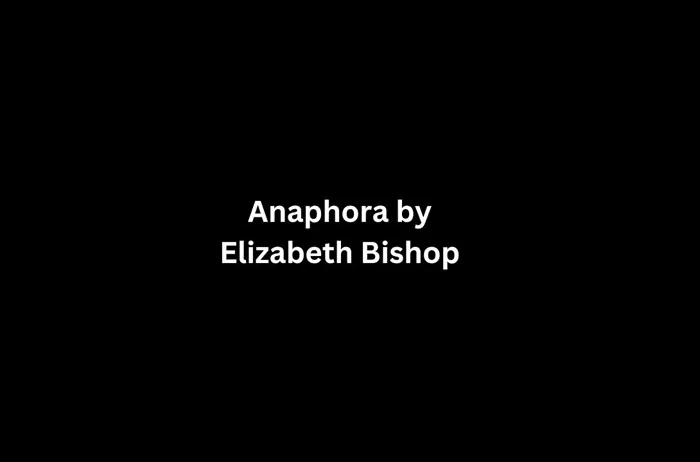Welcome to Poem of the Day – Anaphora by Elizabeth Bishop
Elizabeth Bishop, known for her precise and detailed poetry, often explores themes of nature, human experience, and inner emotional landscapes. One of her works that exhibits her signature style is the poem “Anaphora.” This poem is not only a reflection on repetition but also a meditation on the personal and universal. In this article, we will explore the meaning of the poem “Anaphora,” understand the use of the literary device it is named after, and analyze how Bishop’s craft engages readers with the rhythmic pulse of language.
Anaphora Explanation
Understanding “Anaphora”
The title of Bishop’s poem, “Anaphora,” refers to a rhetorical device that involves the repetition of a word or phrase at the beginning of successive clauses. This repetition creates a rhythmic and almost hypnotic effect, drawing attention to the repeated elements and giving them weight and significance. It’s a technique often used in speeches, prayers, and poetry to emphasize a point and build a sense of momentum.
In Bishop’s “Anaphora,” the device is carefully applied, creating a layered texture that invites the reader to pause and consider the meaning behind each repeated phrase. Through the repetition, Bishop deepens the poem’s impact, allowing the simple act of repetition to reveal complex emotions and insights.
The Structure of “Anaphora”
The poem is divided into short, clear lines, each beginning with the repetition of the phrase “I,” which is a typical feature of anaphora. The repetition highlights Bishop’s focus on the self, giving the reader a sense of intimacy with the speaker. It reflects the speaker’s self-awareness and internal conversation, creating a bridge between the personal and the universal. By repeating “I,” Bishop compels us to reflect on the self in relation to the world and experiences around us.
The structure is spare and direct. The line breaks in the poem help emphasize each repeated phrase, making the reader pause and think about the significance of the repetition. Each phrase seems to lead to another, creating a building sense of reflection that feels like a quiet, ongoing meditation.
Themes of Identity and Self-Reflection
At its core, “Anaphora” is about identity and self-awareness. The repeated use of “I” suggests a focus on the speaker’s inner world, drawing attention to their thoughts, feelings, and actions. It speaks to the struggle of defining oneself in relation to the world, as the speaker seems to grapple with their own sense of identity. The repetition of “I” makes us question the speaker’s relationship with their own self-perception and how they present themselves to the world.
This self-reflection, however, is not static. Instead, it evolves throughout the poem. The use of anaphora gives a sense of movement, as the speaker’s thoughts seem to flow one after the other. Through this technique, Bishop shows that self-reflection is not a singular or one-time act but an ongoing process. The constant repetition of “I” mirrors the persistent nature of self-examination and the complexity of understanding oneself.
The Emotional Resonance of Repetition
Repetition, in any form, carries emotional weight. In “Anaphora,” the repetition of “I” gives the poem a meditative and almost prayer-like quality. It invites the reader to consider the importance of the self in relation to the larger world. This rhythmic return to the same word creates an emotional pull, almost as if the speaker is trying to reach an understanding or make a declaration.
Bishop’s use of repetition also highlights the tension between individuality and universality. While the speaker’s reflections seem personal, the repetitive nature of the poem suggests that these struggles with identity are shared by others. The form of “Anaphora” gives voice to the internal experiences that many of us face when trying to understand who we are in the vastness of the world.
Conclusion
Elizabeth Bishop’s “Anaphora” is a poem that highlights the power of repetition to create emotional depth and clarity. Through the careful use of the rhetorical device, Bishop brings attention to the speaker’s internal world, emphasizing self-reflection and identity. The structure of the poem mirrors the ongoing nature of this process, and the emotional resonance of repetition invites the reader to pause and consider their own relationship with the self.
In its simplicity, “Anaphora” serves as both an exploration of individual consciousness and a universal statement about the human experience. The poem’s rhythmic repetition encourages introspection, allowing readers to connect with their own moments of self-awareness and contemplation. As we read and reflect on Bishop’s work, we are reminded that the act of repetition, in language and thought, can lead to deeper understanding.

